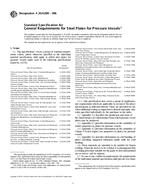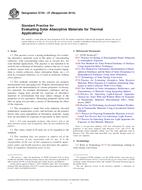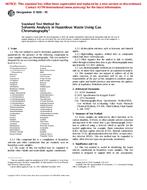1.1 This test method describes the determination of 2,4-toluene diisocyanate (2,4-TDI) and 2,6-toluene diisocyanate (2,6-TDI) in air samples collected from workplace atmospheres in a cassette containing a glass-fiber filter impregnated with 1-(2-pyridyl)piperazine (1-2 PP). This procedure is very effective for determining the vapor content of atmospheres. Atmospheres containing aerosols cause TDI results to be underestimated.
1.2 This test method uses a high-performance liquid chromatograph (HPLC) equipped with a fluorescence or an ultraviolet (UV) detector (1-4). ,
1.3 The validated range of the test method, as written, is from 1.4 to 5.6 μg of 2,4-TDI and 2,6-TDI which is equivalent to approximately 9.8 to 39 ppb for 2,4-TDI and 2,6-TDI based on a 20-L air sample. The HPLC method using an UV detector is capable of detecting 0.078 μg of 2,4-TDI and 0.068 μg of 2,6-TDI in a 4.0-mL solvent volume, which is equivalent to 0.55 ppb for 2,4-TDI and 0.48 ppb for 2,6-TDI based on a 20-L air sample.
1.4 The isomers of 2,4-TDI, and 2,6-TDI, can be separated utilizing a reversed phase column for the HPLC method. Because industrial applications employ an isomeric mixture of 2,4- and 2,6-TDI, the ability to achieve this separation is important.
1.5 The values stated in SI units are to be regarded as standard. No other units of measurement are included in this standard.
1.6 This standard does not purport to address all of the safety concerns, if any, associated with its use. It is the responsibility of the user of this standard to establish appropriate safety and health practices and determine the applicability of regulatory limitations prior to use. See Section 9 for specific precautions.
Product Details
- Published:
- 04/01/2008
- Number of Pages:
- 5
- File Size:
- 1 file , 87 KB
- Redline File Size:
- 2 files , 160 KB


